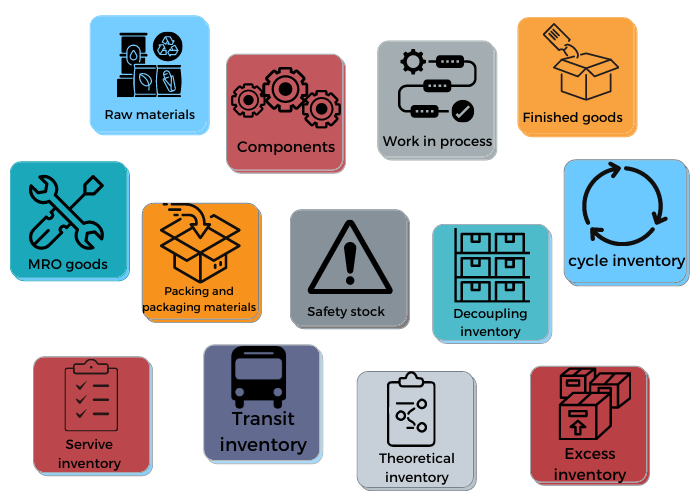What is Inventory Management?
It is the methodical process of sourcing, storing, and selling inventory that a company consumes or sells. Inventory includes both raw materials (components) and finished goods (products).
Inventory management oversees the entire flow of goods from purchase to sale, ensuring that you always have the right stock and quantities available in the right location at the right time.
Understanding the different types of inventories can help to improve customer relations, cash flow, and profitability while also reducing the amount of money lost due to wasted inventory, stockouts, and re-stocking delays.
Check out the 13 types of inventories and examples:
Raw materials
- The input products or inventories that a company needs to make its products are known as raw materials.
- For example, when the product is completed, the raw elements such as the oil needed to make shampoo, are usually indistinguishable from their previous state.
Components
- Components are like raw materials in that they are the materials that a company utilises to make and finish products however, they are still recognisable once the product is completed.
- For example, screws remain recognizable after the product is finished.
Work In progress (WIP)
- Raw materials, labour, and overhead expenditures for items in various phases of the manufacturing process are referred to as WIP.
- For example, if a company sells bags of coffee, bags, labels, coffee beans and shipping boxes are all part of a company’s WIP inventory.
Finished goods
- Finished goods are those that have gone through the necessary manufacturing processes and are ready to be fitted, combined, or processed with the final product.
- For example, a fabric factory may manufacture materials such as cotton or silk that can be used in clothing.
Maintenance, Repair and Operations (MRO) Goods
- MRO refers to components that are used in the manufacturing process but are not included in the final product.
- For example, safety equipment, gloves, computer equipment, etc.
Packaging and packaging materials
- Packaging is any material, container, or wrapping used for or in connection with the transport, handling, protection, marketing, or sale of any Supplies.
- Packaging Material is any material, container, or wrapping used for the containment of the Supplies.
- For example, paper, paperboard, cardboard cartons
Safety Stock and Anticipation Stock
- The additional inventory that a corporation buys and stores to handle unexpected situations is known as safety stock. Anticipation stock is made up of raw materials or completed goods that a company buys in response to sales and production trends.
- For example, pumpkins are in high demand throughout the Halloween season; therefore, the store would order more stock to meet demand.
Decoupling Inventory
- Decoupling inventory or WIP is any inventory set aside to each production line to prevent production slowing or stopping.
- All companies may have safety stock, decoupling inventory is useful if parts of the line work at different speeds and only applies to companies that manufacture goods.
- It acts as a buffer that allows you to continue sales and order fulfillment processes even as production issues are happening.
- For example, in a bakery, the decorators keep a store of sugar roses to decorate wedding cakes. So even if there is no materials to create more sugar roses, the decorators can keep working to deliver a finished cake.
Service Inventory
- Service inventory is a concept in management accounting that refers to how much service a company can deliver in a certain time frame.
- For example, in each week, a hotel with ten rooms has a service inventory of 70 one-night stays.
Transit Inventory
- Any goods shipped by a seller but not yet received by a buyer is considered in transit inventory, also known as transportation inventory or goods in transit.
- For example, ownership is passed to the buyer as soon as the seller ships the items from the warehouse, which is referred to as FOB shipping point.
Theoretical Inventory
- Theoretical inventory, also known as book inventory, is the smallest amount of stock a corporation need to perform an operation without having to wait.
- For example, a restaurant’s theoretical inventory of salad lettuce may be 100 bags a week.
Obsolete Inventory
- Any product in your sitting inventory that is nearing the end of its life cycle and is not expected to be sold is considered excess or surplus inventory.
- For example, if a man makes 800 cookies but only sells 600 the day before the expiry date, the remaining 200 are obsolete inventory.
Cycle Inventory
- Cycle stock, also known as working inventory, is the amount of inventory on hand to match usual demand over a period of time. Based on estimates and historical data, this is the amount of inventory you’d expect to go through.
- For example, as a restaurant uses its last 500 paper napkins, the new refill order arrives. The napkins fit easily in the dedicated storage space.
